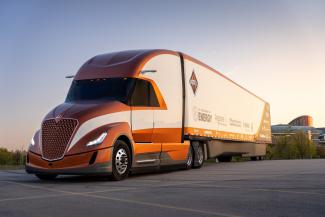Illinois-based Navistar Inc., and their subsidiary International Truck, working in partnership with NETL, developed the Navistar SuperTruck II, which represents the cutting edge of heavy-duty truck design incorporating several improvements resulting in increased operational efficiency, lower costs and decreased fuel consumption.
Co-funded by the U.S. Department of Energy’s (DOE) Office of Energy Efficiency and Renewable Energy Vehicle Technologies Office and managed by NETL, the goal of the SuperTruck program is to deploy more energy-efficient on-road freight transportation. SuperTruck II was built as a hybrid vehicle featuring a combustion engine and high-voltage accessories and technologies, making it easier for future development into fully electric vehicles. Engine improvements were made in key areas, including combustion, friction, gas exchange and airflow through the engine.
The previous SuperTruck I project surpassed DOE requirements in 2015. Building on the success of SuperTruck I, engineers at Navistar developed next-generation technologies in weight reduction, rolling resistance, aerodynamics, and powertrain — all designed to deliver enhanced freight efficiency and help reduce U.S. dependency on fossil fuels in the commercial vehicle sector.
The fundamental philosophy behind the design was an opportunity to develop high-voltage technologies outside of electric vehicles. These efforts were started six years ago, before electric was becoming commercially acceptable in the transportation industry. Achieving 16 miles per gallon in real world operations, SuperTruck II includes a 100% composite box designed for minimum aerodynamic drag with light weight, integrated cross members, controlled underbody flow with composite aero treatments, 6.7-kilowatt solar panels with connectivity options, and ride height control.
SuperTruck II also demonstrated increased freight-ton efficiency, which is measured in ton-miles per gallon and is one of the most effective ways to measure the amount of energy required to transport goods. The most freight-ton efficient trucks make the most of fuel mileage. Thanks to structural composites that are made with lightweight materials, SuperTruck II is lighter and can handle more cargo than SuperTruck I. This also means the fuel it takes to transport each pound of cargo is much less — especially when combined with the truck’s improved fuel efficiency. The 170% improvement in freight efficiency means a much more efficient drive for trucking fleets.
Higher brake thermal efficiency (BTE) is another feature of SuperTruck II. BTE is how the fuel-burning efficiency of an internal combustion engine is measured.
Engines that have a higher percentage of BTE enjoy better overall fuel economy. Many modern truck diesel engines see their BTE hover around 35% to 40%. That means over half of the engine’s potential energy is lost. International SuperTruck II’s 55.2% BTE is an extraordinary engineering accomplishment that makes more efficient use of the engine’s potential energy, which translates to better fuel economy. Finding ways to improve BTE has been a key objective for International Truck. SuperTruck II demonstrates this major step forward to improve customers’ total cost of ownership as well as greenhouse gas emissions.
Navistar’s SuperTruck II goal was to continue with the development of both advanced internal combustion engine technologies and incorporate cross-functional capabilities to our zero-emission products where appropriate. This concurrent approach ensures a smooth transition of technology that best serves the customer needs until there is parity with zero-emission vehicles. The focus was on the entire product ecosystem – product development itself as well as infrastructure charging, service and support of vehicle operation, and end-of-life for batteries.
The SuperTruck II program helps move Navistar forward toward its long-term objective of complete vehicle electrification of which best practices and technology from this program have been incorporated into current programs or future iterations of the zero-emission products. The goal at International Truck is to continue pioneering technologies, accelerate the impact of sustainable mobility, and remain dedicated to delivering new solutions in the generations to come.
NETL is a U.S. Department of Energy national laboratory that drives innovation and delivers technological solutions for an environmentally sustainable and prosperous energy future. By leveraging its world-class talent and research facilities, NETL is ensuring affordable, abundant and reliable energy that drives a robust economy and national security, while developing technologies to manage carbon across the full life cycle, enabling environmental sustainability for all Americans.




